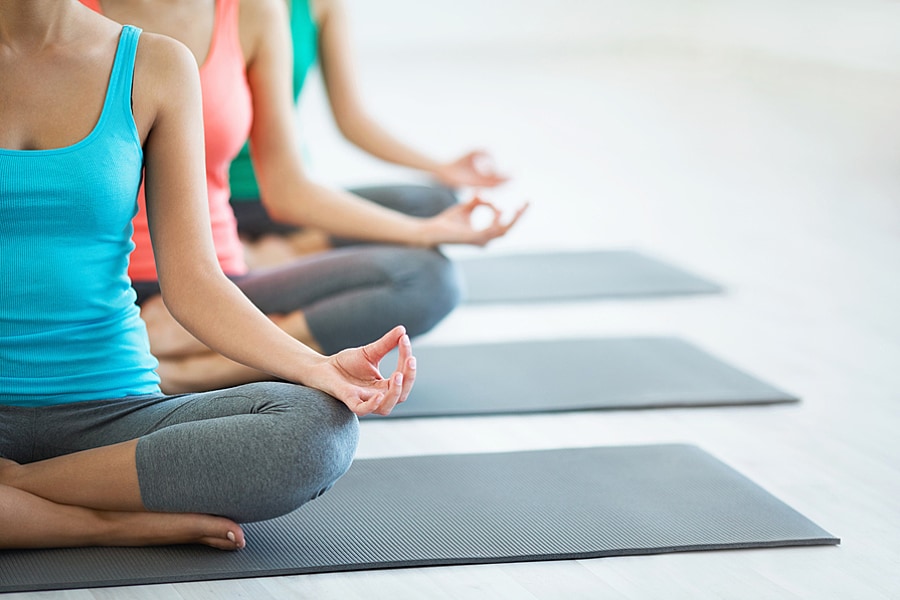These days, trying to decipher the different types of yoga on a studio's schedule can feel like plunging into a bowl of alphabet soup. Ashtanga, Bikram, Kundalini and vinyasa are just some of the options out there. It wasn't always this difficult, but thanks to yoga's growing popularity as a good stress reliever and way to stay active, the number of styles of yoga continues to expand. While different types of yoga may look similar on the surface (classes are based on the same set of yoga poses), each style has a unique approach.
To help you get started, here's a list of eight different types of yoga, plus some insider tips on what to expect in class.
Ashtanga
Founded by K. Pattabhi Jois, Ashtanga yoga is a physically demanding practice. The practice centers around a series of sequenced yoga poses, which you perform in the same order in each class. Ashtanga often starts with five rounds of Sun Salutation A and then five rounds of Sun Salutation B before moving on to a series of standing, seated, and finishing postures. Studios may offer led Primary Series classes, where an instructor calls out the poses of the Ashtanga Primary Series, or a Mysore program, where you perform the yoga poses on your own.
Bikram
When you walk into a Bikram yoga studio, the first thing you'll notice is the heat. Each studio is heated to approximately 105 degrees and 40 percent humidity. During the 90-minute class, you practice a set series of 26 poses, like balancing stick pose and locust pose, and two breathing exercises, which founder Bikram Choudhury believes systematically move oxygenated blood through the body.
Hot Yoga
Like with Bikram, be prepared to sweat. Hot yoga is practiced in a heated room, but teachers don't stick to the prescribed Bikram sequence. Instead, teachers are free to vary the series of poses taught during class. But be careful—while the added heat can help you move deeper into a stretch, it can be easy to overdo it. Listen to your body and don't forget to hydrate.
Iyengar
Precise attention to alignment in each posture is the focus of Iyengar yoga, which was founded by B.K.S. Iyengar. You'll use a variety of props, including blocks, blankets, straps, folding chairs, and even a ropes wall, to help find the proper alignment in each pose. Instead of flowing from pose to pose, you'll hold each posture for a longer period. If you're new to Iyengar, start with a level one class, even if you've practiced yoga before, to learn the basics and foundations of the practice. Classes are typically an hour and a half, and Iyengar yoga can be therapeutic for those with injuries.
Kundalini
If you're looking for a more spiritual and energy-based practice, try Kundalini, which was founded by Yogi Bhajan. Kundalini consists of kriyas, which are repetitive exercises combined with intense breathing (think breath of fire), that can be physically demanding and energizing. Through movement, breath, and sound (chanting), you'll start to stimulate and release untapped energy up your spine and through your energy centers, which are also known as chakras. Classes are typically an hour or more in length.
Restorative
Like Iyengar, restorative yoga classes are prop-heavy. But unlike Iyengar, the focus is on deep rest and relaxation. While you may only move through five or six poses during the hour or more class, you'll hold each pose for five minutes while fully supported by props. Research from the University of California, San Francisco has shown that restorative yoga can decrease levels of cortisol (also known as the stress hormone) in the body and perceptions of stress.
Vinyasa
Vinyasa is a dynamic style of yoga where you link breath and movement, and move from one posture to the next, often to a beat-heavy playlist. Typically, you don't linger in poses for more than a handful of breaths, and because you'll move quickly through sequences of standing and balancing poses, expect your internal thermostat to rise. This vigorous, athletic practice (classes are typically 60 to 90 minutes long) is derived from Ashtanga yoga and builds strength, stamina, and flexibility. Power yoga and flow yoga classes are also vinyasa-style classes.
Yin
Like restorative yoga, yin yoga, which typically consists of seated poses and poses on your back, incorporates props. Poses are held for several minutes without flexing or tensing muscles, and the meditative practice aims to restore length and elasticity to your connective tissue and fascia. Don't be alarmed if you're confused by the names of yin yoga poses, because they are different from what you'll hear in other yoga classes. For example, pigeon is known as sleeping swan in yin yoga, and upavistha konasana is known as dragonfly.
Whether you're new to yoga or ready to take your practice to the next level, don't be afraid to try different classes (and teachers). Start by checking out these eight types of yoga, and keep in mind that it's okay if you don't love every type. Before you know it, you'll find the best yoga style for you.
